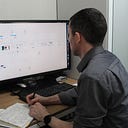(the importance of) Note-Taking, and Usability Testing
#3 Note-Taking
This is the third article, and the start of the compulsory projects, in a look back on the Professional Diploma in UX course projects I created since last April. As the title states, it’s about usability testing and note-taking projects. The actual order was Note-Taking, followed by usability testing, followed by Note-Taking.
I did two usability tests for this project. One online and one in-person (I’m not going to say offline). I planned on making this a blend of both the test and notes, but I have realized that it might be best to include that information separately on another article as a technical walkthrough. So, the next article will explain my somewhat different approaches for online and offline (…sh… I said it) usability tests. [skip to the future]
Handwritten notes first, typed up into XD and Pages. I did two versions, I’ll explain later.
A clever order
The Note-Taking project comes as Project 3 (before actual usability testing). I can see why. You get to watch a sample usability test, examining two different airline apps (or websites, depending on your specialization) with two users. You could look at this usability test as work done by a team member; where you are going to do subsequent note taking. So, you can actually make good use of this Note-Taking project. You can use it as your research, and more importantly — practice.
Online (first) Usability Test Notes
For the notes, I categorized each section of the usability test, while bullet pointing within. Starting with the Depth Interview, on through each step of the booking process. I took quick notes, while also scribbling down some quotes that stood out. Doing this on paper is good, as you can create a visual order very easily and highlight something quickly. I find when typing, I tend to think more about grammar and the content of what I’m typing. That’s good and all, but for this exercise its good to be as objective as possible, and just get the notes down on paper as quickly as possible. We can start to digest it all later.
Formatting this document alone is very helpful in visualizing the User Journey that is to come in the next phase of the course. The research is constantly building upon itself, solidifying and backing itself up piece by piece.
I actually submitted a version of this document that didn’t have the hyperlinked contents page. I put that together for the purpose of the monthly webinar to make it a little easier to flick to where is wanted within the document. The next document I make will definitely have this though as it is really helpful in getting to where you need to when looking back through a lot of research. I cant imagine (yet) the task of finding some specifics from a bank of 10 or 20 such documents of usability test notes. It’s also formatted to A4 as this, in my opinion, is much easier accessible/scannable when printed.
The formatting I will agree on, takes some time to build, though is very effective in breaking up the different stages of the process the user is on.
The goal here was to make this document clear to whoever reads it like UXDI mentors and graders, peers, and collaborators in following projects.
I used two header colours: blue for the introduction section; and red for the actual tests.
For the actual notes, I didn’t add a colour key. It’s something I should have added on the contents page at least, just to take the ‘assumptions are dangerous’ idea off the table. Here it is..
Green for a positive note. Usually followed by a black text quote if available. Bold words or phases for emphasis and to help with scanning the document.
Red for negative notes.
I used blue text for generic and contextual information.
The arrows connecting the boxes were used for follow-up events that I wanted to group together.
After going through each stage of the user’s test that specific ‘Task #’ note section is wrapped up with an ‘Overall Experience’. That’s a kind of summary of the main positive and negative points from the test. A vague image, though a good refresher, again, if you need to find a specific user in a lot of many usability test documents.
These documents took a while to put together. I used XD. It’s not the greatest in terms of word processing though. It is good for moving things around on the large canvas.
When I was to do this again, I had the template ready for it. At the time i felt it was much too time-consuming, so I created a different format for the last usability test.
In-Person (second) Usability Test Notes
After using the document format above for the Sample Usability tests, I wanted to see if a regular formatted text document would be just as effective. You can see below the differences in those.
Takeaway
The bottom notes (Project 4) are much less time consuming knock out, though not as readable. The chunking and linking of information in the first version (top — Project 3) works much better for this document, and the reader should be able to better visualize the timeline of the users actions and feelings during the usability test.
Here are links to both documents ~
